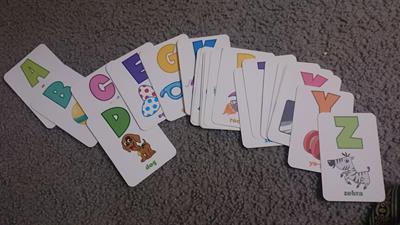How to introduce alphabets and small words to preschoolers

Teaching and parenting go hand in hand to parents. Home schooling is part of it and must for kids between 2-5 age. Language is basic to communication and introducing alphabets is beginning to it. Here are tips to make "alphabet learning" a fun to kids and ease to parents.
Learning starts from the Mother's womb. So teaching alphabets and improving vocabulary before school are not levying a burden on children as long as you are making it a fun learning experience for the kid.
Teaching in practice
Chart method
Hanging an alphabet chart with pictures and words is a common method. It is in practice for many years. This method is a must to be followed because "anything out of sight will become out of mind" easily. When children keep seeing those letters, they will get familiar to it and you can teach them at any time, as it is just hanging on the wall.
ABC song
We are familiar with numerous nursery rhymes and abc is one of the most popular ones. Many of you would have started singing this song to your kid, right from their birth, to make them sleep. Now it is time to make them sing for you. Keep singing this abc song with your kid:"ab cd efg hij k lmnop qrs tuv wx y and z…now I know my abc, next time, won't you sing with me?"
This is my own, a little different, version of the abc song. If you are familiar with any other version, just follow whichever attracts your kid.
TV Rhymes
Download a few abc rhymes, abc phonic rhymes and play it at their TV time. Remember, children should have a TV time to watch, but it should not exceed 2 hours in a day and these 2 hours should be divided into four half an hour sessions or two 1 hour sessions. Get them to practice to this schedule.Activity method
You can make alphabets with objects that are available at home, like spoons, candles, small ropes etc. The same can be done with their toys, such as blocks, small balls, etc and let them try learning when they play with these.Flash cards
You can either get them from a store or make on your own. Cut chart papers into small cards, write Aa, Bb, Cc on one side and paste stickers, if available, or draw Apple, ball, cup on the other side of the card. Ask them to pick a card saying A, B , C...and so on.
Advanced level
If your kids have learned identifying of alphabets, then next thing to do is to ask them to arrange them in sequence. Let them arrange the flash cards or you can use jigsaw puzzles. This will help them in hand -eye co-ordination too.
Do it yourself (DIY)
Colorful learning is fun for kids. Make alphabets with colorful paper. I made alphabets for my kid with pool sponge. I used two colors, Red and Green. Red is for vowels and green for consonants. My kid is only three and I felt is is too early to teach these vowels and consonants, but I just wanted to differentiate it. Also, I thought I could use them in future too. Mostly vowels are used in the middle like bAt, bEd, sIt, cOt, cUp. So, when I form a word, it will look like a colorful combination and easy to remember.Here's what to do:
1. Cut the sponge vertically but don't separate into two pieces, let them remain cylindrical and straight.

2. Write alphabets with a permanent marker
Now separate each alphabet by cutting them into pieces

Hang the alphabets in a pipe and teach simple words


Another method: Use a white board, write 5 words everyday, pronounce it, spell it, explain the meaning and don't forget to use them often, so that, kids could easily relate to it and remember it. If you could show that object associated with it, then show it. For example, for the word cup, show the cup to the kid and use this word whenever possible like, "bring the cup", "you eat from this cup", etc Ask him/her to tell c u p - cup.


Make it interesting when you introduce children to the world of alphabets. First, get charts; even digital charts are available in the market today that comprise of phonics. They can just visualize the letters of ABC and then let them hear the sound of the letters by the means of phonics. Let them know how each letters sounds in a different way. Then teach them one by one, what A stands for and so on. Just take a stick and carve on walls of your premises with a stick. let them know how the letters can be written.